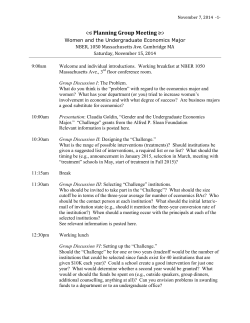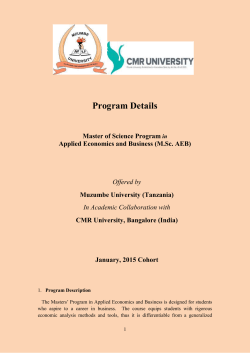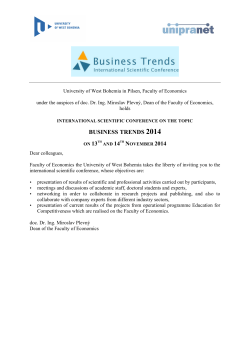
ECON 351: Behavioural Economics (18 Points)
DEPARTMENT OF ECONOMICS ECON 351: Behavioural Economics (18 Points) Semester 1, 2014 1. Course Description Economic models often presume (at least implicitly) that decision-makers are rational, self-interested, fully informed, and endowed with perfect foresight. It is not difficult to find violations of each of these precepts in real-world economic behaviour, and the study of the “limits to rationality” has become a vibrant and rapidly growing field within economics. This paper will focus on developing theoretical models that capture some of the more “psychological” phenomena observed in the marketplace. In the process we will review relevant theories from within economics, as well as evidence from other disciplines such as social psychology, anthropology, and neuroscience. Prerequisites. 18 200-level ECON points; or consent of the instructor. Lectures. Three hours per week: Monday 9:00–9:50am, Wednesday 10:00–10:50am, Friday 10:00–10:50am. See PIMS for locations. 2. Learning Aims and Objectives This course aims to introduce students to key theories, issues and problems in the area of behavioural economics. Particular emphasis will be placed upon considering evidence from a broad spectrum of the behavioural sciences, and incorporating this evidence into economic theory. 3. Course staff Course Coordinator and Lecturer Dr Trent Smith 701 Commerce Building e-mail: trent.smith@otago.ac.nz Office hours: TBA Receptionist Sandra Soeder 701A Commerce Building Office hours: 9:00-3:30 If you are missing copies of handouts or other course materials, please see Sandra Soeder at reception (Commerce 701A) or download these from Blackboard. 4. Notices & Blackboard The Department of Economics is housed on the 7th Floor of the Commerce Building. Administrative notices and assignments will be posted on Blackboard: http://blackboard. otago.ac.nz (enter your username & password). Slides will also be posted on Blackboard when available. Blackboard allows us to e-mail the whole class. As such, e-mails will be sent to your student e-mail address, so it is important that you check your student e-mail regularly. In particular, students can expect to receive notice of short reading assignments or problems to be solved, up to 6:00pm the evening before a lecture. If you have any difficulties using Blackboard, contact the ITS Library Helpdesk on 479 8888 or e-mail helpdesk@otago.ac.nz. 5. Class Representatives One or more Class Reps will be chosen from among the students enrolled in the class sometime during the 1st week of lectures. Class Reps are able to discuss problems with you and, if you wish, take them to the lecturers or to the Head of Department. 6. Workload You should plan to devote 12 hours per week to this course. This is based on the University’s ‘rule of thumb’ for an 18 point Semester course. Three of these hours are spent in lectures each week–leaving nine hours per week for your own reading and study and revision. 7. Maths in this Paper While a good part of the content of this paper will be devoted to the study of empirical evidence across the behavioural sciences, we will also aim to develop formal (i.e., mathematical) economic models of the behavioural phenomena we study. Familiarity with differential calculus (i.e., partial derivatives) and the ability to solve simple systems of 2 linear equations are likely to be advantageous for students. If you are unfamiliar with these concepts, there is time to catch up, but you will need to put in effort. 8. Assessment There will be a midterm test (worth 15%) and a three-hour final examination (worth 60%). In addition, two forms of assessment will measure student comprehension and contribution to the learning environment during and after lecture: clickers (worth 10%), and short weekly “journal” essays (worth 15%). Each of these is described in more detail below. Clickers. A “clicker” is a mobile handheld device that allows students to answer multiple choice questions during lecture. Each student will be issued a clicker during the first week of class, and will be responsible for bringing it to each lecture and returning it in original condition at the end of the term. Clickers will be used in this class for the purposes of fostering discussion and for testing student comprehension of assigned readings, problem sets, and lecture material. Unless otherwise stated, clicker marks will be calculated as follows: correct responses (or any response, if the question has no incorrect answer) receive 10 points; incorrect responses receive 5 points. For each lecture in which clicker responses are recorded, an average score over all questions asked that day will be calculated. At the end of the term, the 9 lowest lecture-scores (including any zeros owing to necessary absences, equipment malfunctions, etc.) will be dropped and the average calculated from among the remainder. Journal. Students will be expected to submit short “journal” essays approximately once per week. These offer an opportunity to provide commentary on the week’s lectures and reading assignments, demonstrate comprehension of the material, and to engage in inquiry. A length restriction of 150-250 words will apply unless otherwise noted. Late submissions will not be accepted, but up to two essays may be missed without penalty. All essays are to be submitted electronically; detailed requirements will be provided. Midterm Test. The midterm test will take place during lecture time. The exact date and details of what it will cover will be provided in lectures. Examination. The final examination will be comprehensive. Special Consideration. If you consider your performance in the end-of-semester examination to be seriously impaired, or if you are too ill to sit an examination, you can apply for Special Consideration. To do this you will need to obtain an application form from the University Information Centre or Student Health. Please note that applications for Special Consideration must be made within five calendar days from the date of the last examination for which the application applies and must be accompanied by supporting documentation, such as a medical certificate. 3 9. A note on Dishonest Practice Any student found responsible for dishonest practice (for example, copying, the use of unauthorised material in tests, etc.) in relation to any piece of work submitted for assessment shall be subject to the University’s dishonest practice regulations and may result in various penalties, including forfeiture of marks for the piece of work submitted, a zero grade for the paper, or, in extreme cases, exclusion from the University. 10. Topics List A tentative list of topics to be covered is given below. Actual topics covered may vary, owing to both student interest and time constraints. (1) Introduction: rational choice, behavioural economics, and philosophy of science (2) Uncertainty: expected utility theory (EU), EU anomalies, subjective probability, risk attitudes (3) Experimental Economics: theory and practice (4) Economics of Self-Control: discounted utility, hyperbolic discounting, obesity and “overeating” (5) Neuroeconomics: what’s going on inside the decision-maker’s head (6) Addiction & Habit Formation: search theory, learning models, evolution of dietary preferences (7) Market Manipulation: private information, herding, propaganda (8) Behavioural Law & Economics: legal theory informed by social psychology 11. Textbook Though the lectures will not closely follow any single textbook, it is anticipated that several readings will be drawn from An Introduction to Behavioral Economics by Nick Wilkinson (2008). A copy of this text will be placed on close reserve in the Central Library, but students may wish to consider purchasing a copy of their own. Other readings will be made available via Blackboard. The list of Selected Readings that follows should be taken as indicative of the breadth of scholarly knowledge students can expect to draw upon in this paper. Specific reading assignments will be given as the semester progresses. 12. Selected Readings Baron-Cohen, S., Leslie, A. M., and Frith, U. (1986). Mechanical, behavioural and intentional understanding of picture stories in autistic children. British Journal of Developmental Psychology, 4(2):113125. Beauchamp, J. P., Cesarini, D., Johannesson, M., van der Loos, M., Koellinger, P., Groenen, P., Fowler, J. H., Rosenquist, J. N., Thurik, R., and Christakis, N. A. (2011). Molecular genetics and economics. Journal of Economic Perspectives, 25(4):57–82. 4 Becker, G. S., Grossman, M., and Murphy, K. M. (1994). An empirical analysis of cigarette addiction. American Economic Review, 84:396–418. Becker, G. S. and Murphy, K. M. (1988). A theory of rational addiction. Journal of Political Economy, 96(4):675–700. Benforado, A., Hanson, J., and Yosifon, D. (2004). Broken scales: Obesity and justice in america. Emory L. J., page 1645. Bernays, E. L. (1928). Propaganda. Routledge. Boyd, R. and Silk, J. B. (2012). How Humans Evolved, Sixth Edition. W.W. Norton, New York. Camerer, C., Loewenstein, G., and Prelec, D. (2005). Neuroeconomics: How neuroscience can inform economics. Journal of Economic Literature, 43(1):9–64. Cartwright, E. (2011). Behavioral Economics. Routledge, New York. Cela Conde, C. J. and Ayala, F. J. (2007). Human evolution trails from the past. Oxford University Press, Oxford; New York. Chen, C., Burton, M., Greenberger, E., and Dmitrieva, J. (1999). Population migration and the variation of dopamine D4 receptor (DRD4) allele frequencies around the globe. Evolution and Human Behavior, 20(5):309–324. Chen, M., Lakshminarayanan, V., and Santos, L. (2006). How basic are behavioral biases? Evidence from capuchin monkey trading behavior. Journal of Political Economy, 114(3):517–537. Chiara, G. D. (1999). Drug addiction as a dopamine-dependent associative learning disorder. European Journal of Pharmacology, 375:13–30. Cialdini, R. B. (1984). Influence: How and Why People Agree to Things. William Morrow, New York. Clark, C. W. and Ekman, J. (1995). Dominant and subordinate fattening strategies: a dynamic game. Oikos, 72:205–212. Cosmides, L. (1989). The logic of social exchange: Has natural selection shaped how humans reason? Studies with the Wason selection task. Cognition, 31(3):187–276. Dasgupta, P. and Maskin, E. (2005). Uncertainty and hyperbolic discounting. The American Economic Review, 95(4):1290–1299. Dobzhansky, T. (1973). Nothing in biology makes sense except in the light of evolution. The American Biology Teacher, 35(3):125–129. Farooqi, I. S. and O’Rahilly, S. (2005). Monogenic obesity in humans. Annual Review of Medicine, 56(1):443–458. PMID: 15660521. Ferrie, J., Shipley, M., Marmot, M., Stansfeld, S., and Smith, G. (1998). An uncertain future: The health effects of threats to employment security in white-collar men and women. American Journal of Public Health, 88(7):1030–1036. 5 Friedman, M. (1953). The methodology of positive economics. In Friedman, M., editor, Essays in Positive Economics, chapter 1. University of Chicago Press. Garcia, J. and Koelling, R. A. (1966). Relation of cue to consequence in avoidance learning. Psychonomic Science, 4(3):123–124. Gazzaniga, M. S. (1998). The split brain revisited. Scientific American, 279(1):50–55. PMID: 9648298. Gazzaniga, M. S. (2000). Cerebral specialization and interhemispheric communication: Does the corpus callosum enable the human condition? Brain, 123:1293–1326. Gazzaniga, M. S., Ivry, R. B., and Mangun, G. R. (2008). Cognitive Neuroscience: The Biology of the Mind, Third Edition. W.W. Norton. Gilboa, I. (2010). Rational Choice. MIT Press, Cambridge, Massachusetts. Grether, D. M. and Plott, C. R. (1979). Economic theory of choice and the preference reversal phenomenon. American Economic Review, 69(4):623–638. Gruber, J. and K¨oszegi, B. (2001). Is addiction ‘rational’ ? theory and evidence. The Quarterly Journal of Economics, 116(4):1261–1303. Hanson, J. and Yosifon, D. (2004). The situational character: A critical realist perspective on the human animal. Georgetown Law Journal, 93(1):1–179. Harbaugh, R. (2005). Prospect theory or skill signaling? Working Paper 2005-06, Indiana University, Kelley School of Business, Department of Business Economics and Public Policy. Holt, C. A. (2007). Markets, Games, & Strategic Behavior. Pearson, Boston. Kahneman, D. (2011). Thinking, fast and slow. Allen Lane, London. Kahneman, D., Knetsch, J. L., and Thaler, R. H. (1990). Experimental tests of the endowment effect and the coase theorem. Journal of Political Economy, 98(6):1325– 1348. Kahneman, D. and Tversky, A. (1979). Prospect theory: An analysis of decision under risk. Econometrica, 47(2):263–291. Korsten, P., Mueller, J. C., Hermannstadter, C., Bouwman, K. M., Dingemanse, N. J., Drent, P. J., Liedvogel, M., Matthysen, E., van Oers, K., van Overveld, T., Patrick, S. C., Quinn, J. L., Sheldon, B. C., Tinbergen, J. M., and Kempenaers, B. (2010). Association between DRD4 gene polymorphism and personality variation in great tits: a test across four wild populations. Molecular Ecology, 19(4):832–843. Kosfeld, M., Heinrichs, M., Zak, P. J., Fischbacher, U., and Fehr, E. (2005). Oxytocin increases trust in humans. Nature, 435(7042):673–676. Kuhn, T. S. (1996). The Structure of Scientific Revolutions, Third Edition. University of Chicago Press, Chicago. Loewenstein, G. and Thaler, R. H. (1989). Anomalies: Intertemporal choice. The Journal of Economic Perspectives, 3(4):181–193. 6 Loomes, G. and Sugden, R. (1982). Regret theory: An alternative theory of rational choice under uncertainty. The Economic Journal, 92(368):805–824. Mas-Colell, A., Whinston, M. D., and Green, J. R. (1995). Microeconomic Theory. Oxford University Press. McDermott, R., Fowler, J. H., and Smirnov, O. (2008). On the evolutionary origin of prospect theory preferences. The Journal of Politics, 70(02):335–350. Nelson, R. J. (2011). An Introduction to Behavioral Endocrinology, Fourth Edition. Sinauer, Sunderland, MA. Offer, A., Pechey, R., and Ulijaszek, S. (2010). Obesity under affluence varies by welfare regimes: The effect of fast food, insecurity, and inequality. Economics and Human Biology, 8:297–308. Plott, C. R. and Zeiler, K. (2005). The willingness to pay-willingness to accept gap, the ‘endowment effect,’ subject misconceptions, and experimental procedures for eliciting valuations. American Economic Review, 95(3):530–545. Rabin, M. (1998). Psychology and economics. Journal of Economic Literature, 36(1):pp. 11–46. Rodrigues, S. M., Saslow, L. R., Garcia, N., John, O. P., and Keltner, D. (2009). Oxytocin receptor genetic variation relates to empathy and stress reactivity in humans. Proceedings of the National Academy of Sciences, 106(50):21437–21441. PMID: 19934046. Roe, B. E., Tilley, M. R., Gu, H. H., Beversdorf, D. Q., Sadee, Wolfgang amd Haab, T. C., and Papp, A. C. (2009). Financial and Psychological Risk Attitudes Associated with Two Single Nucleotide Polymorphisms in the Nicotine Receptor (CHRNA4) Gene. PLoS One, 4(8):Article No. e6704. Ross, L. and Nisbett, R. E. (1991). The Person and the Situation: Perspectives of Social Psychology. McGraw-Hill, New York. Sanfey, A. G., Rilling, J. K., Aronson, J. A., Nystrom, L. E., and Cohen, J. D. (2003). The neural basis of economic decision-making in the ultimatum game. Science, 300(5626):1755–1758. PMID: 12805551. Sapolsky, R. M. (1990). Stress in the wild. Scientific american, 262(1):116–123. Sapolsky, R. M. (1992). Cortisol concentrations and the social significance of rank instability among wild baboons. Psychoneuroendocrinology, 17(6):701–709. Smith, T. G. (2004). The McDonald’s equilibrium: Advertising, empty calories, and the endogenous determination of dietary preferences. Social Choice and Welfare, 23(3):383– 413. Smith, T. G. (2009). Reconciling psychology with economics: Obesity, behavioral biology, and rational overeating. Journal of Bioeconomics, 11(3):249–282. Smith, T. G. and Tasn´adi, A. (2007). A theory of natural addiction. Games and Economic Behavior, 59:316–344. 7 Sozou, P. (1998). On hyperbolic discounting and uncertain hazard rates. Proceedings of the Royal Society of London B: Biological Sciences, 265(1409):2015–2020. Stigler, G. J. (1950). The development of utility theory. II. Journal of Political Economy, 58(5):373–396. Sugden, R. (1993). An axiomatic foundation for regret theory. Journal of Economic Theory, 60(1):159–180. Wilkinson, N. (2008). An Introduction to Behavioral Economics. Palgrave Macmillan, London. 8
© Copyright 2025









